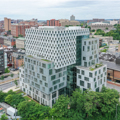Founded in 1925 as a private institution to provide evening classes in business and law, the University of Baltimore became public in 1975 and part of the University System of Maryland in 1988. The most recent addition to its urban campus is the Angelos Law Center opened in 2013. Its design by the German firm Behnisch Architekten in partnership with Baltimore firm Ayers/Saint/Gross was selected in 2008 through an international competition for a landmark new building for the law school. Incorporating green roofs, rainwater capture, and other innovations in sustainable design, the Angelos Center rises twelve stories around a central atrium. Its mirrored glass and steel facade is enlivened by stacked, block-like forms sheathed in a variety of irregular fenestration patterns, creating a unique, contemporary landmark in central Baltimore. The Student Center opened in 2006 (Murphy and Dittenhaufer; 21 W. Mount Royal Avenue) is another noteworthy contemporary building on campus, with the curving, zinc-coated copper sheathed form at the top enclosing a two-hundred-seat theater.
You are here
UNIVERSITY OF BALTIMORE, JOHN AND FRANCES ANGELOS LAW CENTER
If SAH Archipedia has been useful to you, please consider supporting it.
SAH Archipedia tells the story of the United States through its buildings, landscapes, and cities. This freely available resource empowers the public with authoritative knowledge that deepens their understanding and appreciation of the built environment. But the Society of Architectural Historians, which created SAH Archipedia with University of Virginia Press, needs your support to maintain the high-caliber research, writing, photography, cartography, editing, design, and programming that make SAH Archipedia a trusted online resource available to all who value the history of place, heritage tourism, and learning.










